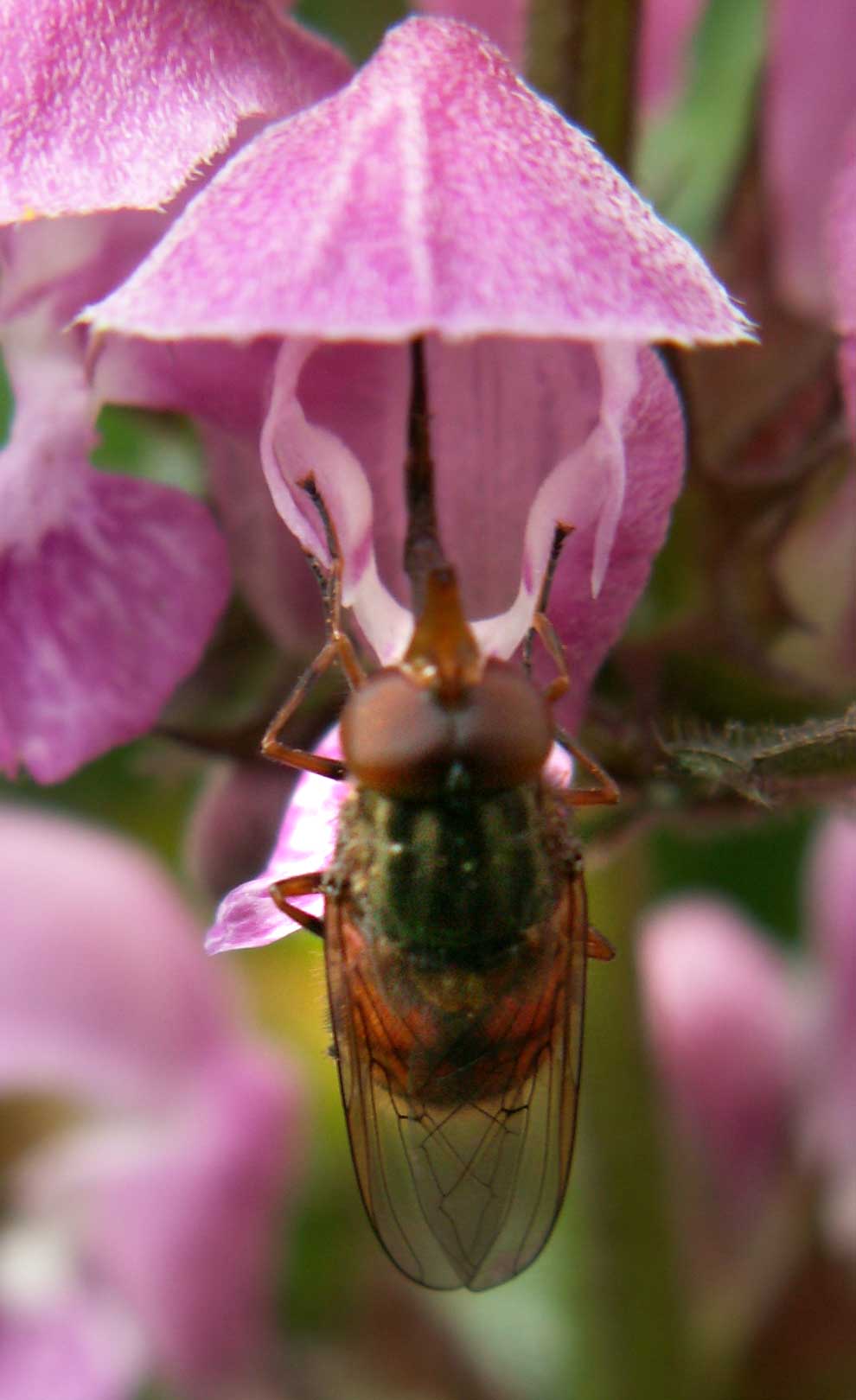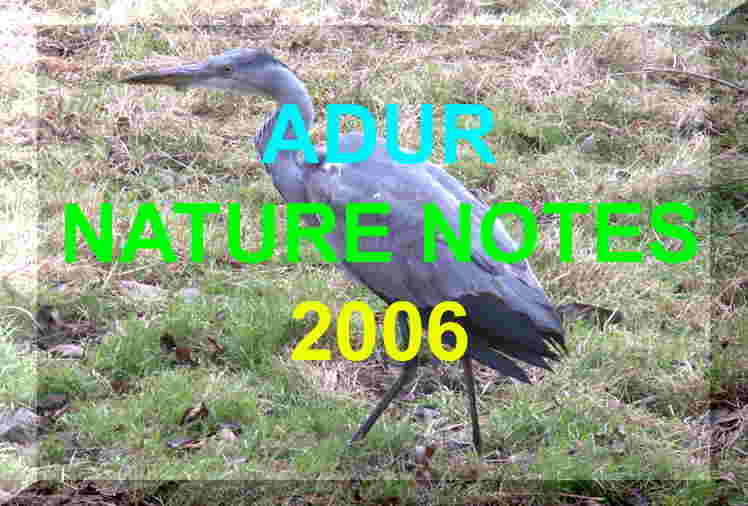Hoverflies 2007
4 December
2006
A
late Eupeodes hoverfly
visited a garden Gentian
in my west Lancing garden.
Image
21
November 2006
A
Marmalade
Hoverfly,
Episyrphus
balteatus, was spotted on a remaining
Greater
Knapweed flower on the Pixie
Path to Mill Hill.
| 1
November 2006
A half a dozen of these small hoverflies were spotted in the copse at the top of Mill Hill. I did not realise at the time that they were Marmalade Hoverflies Episyrphus balteatus. They were smaller than normal. |
 |
 |
23
October 2006
A
single hoverfly Rhingia
campestris landed on a dead leaf on
the lower slopes of Mill
Hill.
18
October 2006
A
medium-sized hoverfly visited a Dandelion
near Cuckoo's Corner. It had white
vertical stripes on its dark brown thorax and a black and yellow patterned
abdomen, so it could be Helophilus
sp? but the image was not clear or large enough
to be sure of the species.
Enhanced
Image
16
October 2006
 In
the sunshine (with strong shadows as the sun was low in the sky), I noticed
in passing the occasional Marmalade Hoverflies
Episyrphus
balteatus and
Drone Flies
Eristalis
mostly in the Butterfly Copse next to the Waterworks
Road and on the Pixie Path to Mill
Hill. Myathropa florea
was noticed in the latter location. Two Greater
Knapweed flowers on the path verges attracted
one hoverfly which looked very much like a Rhingia,
but it flew off too quickly to be sure. This location was next to wear
the horse dung is usually piled up, but it was missing this year and there
was only one horse
in the field.
In
the sunshine (with strong shadows as the sun was low in the sky), I noticed
in passing the occasional Marmalade Hoverflies
Episyrphus
balteatus and
Drone Flies
Eristalis
mostly in the Butterfly Copse next to the Waterworks
Road and on the Pixie Path to Mill
Hill. Myathropa florea
was noticed in the latter location. Two Greater
Knapweed flowers on the path verges attracted
one hoverfly which looked very much like a Rhingia,
but it flew off too quickly to be sure. This location was next to wear
the horse dung is usually piled up, but it was missing this year and there
was only one horse
in the field.
8 October
2006
There
were occasional Marmalade Hoverflies Episyrphus
balteatus and
Drone Flies
Eristalis
on
the wasteland just outside of Shoreham town, notably the verges of the
the Waterworks Road, Old
Shoreham.
18
September 2006
There
was a hoverfly Rhingia campestris,
seen on the Buddleia
leaf near next to the cyclepath north
of the Cement Works.
16
September 2006
 The
Ivy in the Butterfly Copse next to the Waterworks
Road was covered in flying insects including at least two Volucella
zonaria hoverflies,
occasional Myathropa florea hoverflies,
frequent Drone Flies
Eristalis
hoverflies,
and one or two Eupeodes
? species
of hoverflies.
The
Ivy in the Butterfly Copse next to the Waterworks
Road was covered in flying insects including at least two Volucella
zonaria hoverflies,
occasional Myathropa florea hoverflies,
frequent Drone Flies
Eristalis
hoverflies,
and one or two Eupeodes
? species
of hoverflies.
15
September 2006
A
Volucella
zonaria was spotted on the Ivy in
the Butterfly Copse next to the Waterworks
Road with Myathropa florea (Occ),
Marmalade
Hoverflies Episyrphus
balteatus (Occ), Drone Flies
Eristalis
(Freq).
There was a Helophilus
pendulus hoverfly in a field to
the west of Spring Dyke by the Steyning
Road.
9 September
2006
The
scarce hoverfly Rhingia rostrata
was seen and photographed
at Woods Mill,
Small Dole.
Image
One
Image
Two
30
August 2006
One
of the spectacular hoverflies Volucella
zonaria actually landed on my bicycle
tyre as I was wheeled my bike up the Pixie
Path to Mill Hill.
6 August
2006
One
of the larger orange Volucella hoverflies
flew into a spider's orb web
in the Hawthorn scrub in the north-west
of Mill Hill. When I got closer, it broke
free and flew off rapidly. Hoverflies were not being noted but Episyrphus
balteatus was common, the small
Sphaerophoria
scripta frequent, and the widespread
Myathropa
florea noticed occasionally every
day.
 |
23
July 2006
The first of the spectacular hoverflies Volucella zonaria of the year was spotted on the south side Buckingham Cutting. Episyrphus balteatus were present in scores, Sphaerophoria scripta and Syrphus, but these are common and expected and I did not make notes. |
 |
 |
|
This hoverfly can be recognised in flight by the the yellow stripes on the side of its thorax. It hovered in mid-air frequently. |
(ID to species not confirmed) Hovering was spasmotic and not distinctive, with more flitting about than hovering. Note the wing position. |
On
the verges of the Waterworks Road, two
small and distinctive flying insects were seen, the first one (left above)
near where the private road meets the Steyning Road, and the second wasp
(above right) on the path next to Frampton's Field just east of the Butterfly
Copse.
Adur
Bees & Wasps
A distinctive
hoverfly, the bumblebee mimic Volucella
bombylans var. plumata
was quickly spotted at the western entrance to the Field Maple spinney
(called
the Maple Spinney) footpath between the Waterworks
Road and the Steyning Road.
| 23
& 27 June 2006
This hoverfly was seen hovering in the Slonk Hill Cutting mixed meadow, and it would not keep still long enough for a decent photograph. I have identified it as Xanthogramma pedissequum. |
 |
23
June 2006
Volucella
bombylans var. plumata was
recorded in the scrub in the
north-west
part of Mill Hill Nature
Reserve. Marmalade Hoverflies,
Episyrphus
balteatus, were seen frequently. On
the south side of the Slonk Hill Cutting there
was small yellow-orange hoverfly that would not keep still long enough
for a photograph.
20
June 2006
The
hoverfly Rhingia
campestris
fed on Greater
Knapweed on the middle Triangle
area of Mill Hill.
15
June 2006
The
bumblebee
mimic Volucella
bombylans var. bombylans with
an orange tail was seen along the path that is becoming overgrown with
Dogwood
in parts in the north-west part of Mill
Hill Nature Reserve.
5 June
2006
There
were hoverflies including Volucella
bombylans var. plumata and
Myathropa
florea in the Butterfly
Copse (TQ 209 063) near
the Waterworks Road.
4 June
2006
The
hoverfly Merodon
equestris was present on the path
on the south side of the Slonk Hill Cutting.
The hoverfly Volucella
bombylans var. bombylans was the
only thing of interest in the hopelessly overgrown entrance to Spring
Dyke from the Steyning Road.
2 June
2006
A
Merodon
equestris hoverfly landed repeatedly
on the the Pixie Path.
 |
28
May 2006
The wasp mimic is a hoverfly, a species of Chrysotoxum in the dense meadows north-west of the upper car park on Mill Hill. I think
this is Chrysotoxum
verralli
Diptera.com
Images
|
18
May 2006
The
hoverfly Myathropa florea was
present in the Butterfly Copse (by the Waterworks
Road) as is usual every year.
 |
 |
This small hoverfly was recorded on the western part of Anchor Bottom, near Dacre Gardens. It looks like Melanostoma scalare.
 |
 |
 |
| 7
May 2006
Two firsts of the year were recorded, one of my favourites, despite being common, Myathropa florea, because of its epistrophic behaviour, in a north Shoreham garden, and the attractive Leucozona lucorum on the Pixie Path. |
 |
 |
| 3
May 2006
Late in the afternoon the small hoverfly on the right was seen on Alexanders on the Waterworks Road (Old Shoreham). Epistrophe eligans This is a common species found in gardens. |
 |
30
April 2006
 |
 |
The
photographic study shows the Rhingia
campestris
hoverflies in a north Shoreham
garden.
The first one is visiting the Spotted Deadnettle,
Lamium
maculatum, and its long tongue is visible.
Rhingia
campestris Study
29
April 2006
At
the top of The Drive, hoverflies
were frequent including the first Helophilus
pendulus of the year. Syrphus
hoverflies seem to come in two different sizes, small (these are probably
Eupeodes
[=Metasyrphus]) and medium. Eristalis
tenax were occasionally seen.
 |
 |
 |
 |
There
were two small species that have not yet been identified to genus level.
The
one in the photographs above are under identification investigation. I
am beginning with the Platycheirus
genus. My determination was the species Platycheirus
scutatus. The consensus
is that it was Platycheirus albimanus.
It is a species very frequently seen. Note that the antennae
are black in this small hoverfly. The
scutellum
is dark brown/black
as well.
Enlarged
Images
Entomology
Glossary
Postscript:
This
is a Platycheirus scutatus,
almost certainly sensu stricto
(as opposed to P. splendidus
etc). It was quite common at Poverty Bottom, Sussex.
on the UK Hoverflies Yahoo Group
Rhingia were present but not as many as the dozen or so in a north Shoreham garden visiting Spotted Deadnettle, Lamium maculatum (pic).
26
April 2006
 |
 |
 |
Other garden species included at least one Eristalis and a definite Rhingia, distinguished by its snout. There was also one of the small hoverflies seen two days ago, possibly a Platycheirus. |  |
 |
 |
 |
A series of two Melanostoma scalare males and one female. 1 April 2006
 23
January 2006
23
January 2006and the Dipterist's General Forum
Lancing
Hoverflies Database Records (by Ray Hamblett)
Lancing
Flies (Diptera) Gallery (by Ray Hamblett)
Adur Hoverflies > 2005
